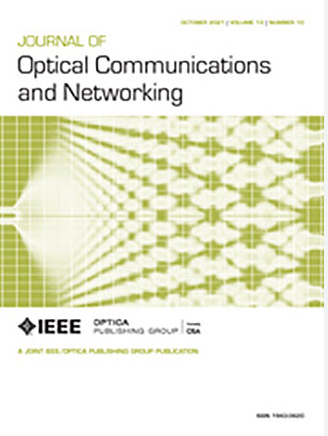Cost-effective and reliable multi-period optical network planning comparing capacity and topology upgrades
IF 4.3
2区 计算机科学
Q1 COMPUTER SCIENCE, HARDWARE & ARCHITECTURE
引用次数: 0
Abstract
This paper investigates cost-effective and reliable multi-period planning of optical networks. To meet the expected demand increase, three planning optimization approaches are proposed and compared: spatial division multiplexing using the C-band (SDM-CB), ultra-wideband transmission in the C + L bands (UWB-MB), and topology upgrade (TopUp-CB). Each approach is evaluated through an integer linear programming formulation based on a cost model that considers the costs of lightpaths, fiber deployment, and link installation under two reliability requirements: 1 + 1 demand protection and minimal bit error rate (BER) for signal transmission. Simulation results on the Nobel Germany and NSFNET topologies reveal critical trade-offs between cost and resource utilization to prevent blocking. For Nobel Germany, UWB-MB requires 50% fewer fibers than SDM-CB but is 5% more expensive under high L-band transceiver costs. For NSFNET, when a lower transmission BER is required, the planning costs increase up to 150% compared to a higher BER value, while TopUp-CB can reduce the costs by up to 35% and 25% through the optimal addition of new links compared to SDM-CB and UWB-MB, respectively. These findings provide actionable guidelines for network operators to select the most suitable planning strategies under varying cost, capacity, and reliability constraints.性价比高、可靠性高的多周期光网络规划,比较容量和拓扑升级
本文研究了经济、可靠的光网络多周期规划。为了满足预期的需求增长,提出并比较了三种规划优化方法:C波段空分复用(SDM-CB)、C + L波段超宽带传输(UWB-MB)和拓扑升级(TopUp-CB)。每种方法都通过基于成本模型的整数线性规划公式进行评估,该模型考虑了光路、光纤部署和链路安装在两种可靠性要求下的成本:1 + 1需求保护和信号传输的最小误码率(BER)。诺贝尔德国和NSFNET拓扑的仿真结果揭示了成本和资源利用之间的关键权衡,以防止阻塞。对于诺贝尔德国来说,UWB-MB所需的光纤比SDM-CB少50%,但在高l波段收发器成本下,其成本要高出5%。对于NSFNET,当传输BER要求较低时,与较高的BER值相比,规划成本最多增加150%,而与SDM-CB和UWB-MB相比,top - up - cb通过最优添加新链路可分别减少35%和25%的成本。这些发现为网络运营商在不同成本、容量和可靠性约束下选择最合适的规划策略提供了可操作的指导方针。
本文章由计算机程序翻译,如有差异,请以英文原文为准。
求助全文
约1分钟内获得全文
求助全文
来源期刊
CiteScore
9.40
自引率
16.00%
发文量
104
审稿时长
4 months
期刊介绍:
The scope of the Journal includes advances in the state-of-the-art of optical networking science, technology, and engineering. Both theoretical contributions (including new techniques, concepts, analyses, and economic studies) and practical contributions (including optical networking experiments, prototypes, and new applications) are encouraged. Subareas of interest include the architecture and design of optical networks, optical network survivability and security, software-defined optical networking, elastic optical networks, data and control plane advances, network management related innovation, and optical access networks. Enabling technologies and their applications are suitable topics only if the results are shown to directly impact optical networking beyond simple point-to-point networks.

 求助内容:
求助内容: 应助结果提醒方式:
应助结果提醒方式:


